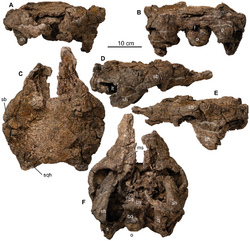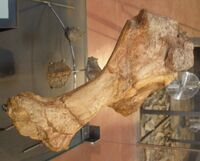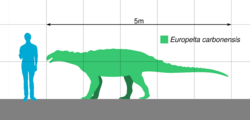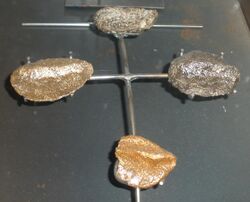Biology:Struthiosaurinae
| Struthiosaurines | |
|---|---|

| |
| Skull of Europelta | |
| Scientific classification | |
| Domain: | Eukaryota |
| Kingdom: | Animalia |
| Phylum: | Chordata |
| Clade: | Dinosauria |
| Clade: | †Ornithischia |
| Clade: | †Thyreophora |
| Suborder: | †Ankylosauria |
| Family: | †Nodosauridae |
| Subfamily: | †Struthiosaurinae Nopcsa, 1923 |
| Type species | |
| †Struthiosaurus austriacus Bunzel, 1871
| |
| Genera[1] | |
Struthiosaurinae is a subfamily of ankylosaurian dinosaurs from the Cretaceous of Europe. It is defined as "the most inclusive clade containing Europelta but not the North American Cedarpelta, Peloroplites, Sauropelta or Edmontonia" while being reinstated for a newly recognized clade of basal nodosaurids. Struthiosaurinae appeared at about exactly the same time as the North American subfamily Nodosaurinae. Struthiosaurines range all across the Cretaceous, the oldest genus being Europelta at an age of 112 Ma and the youngest being Struthiosaurus at about 85–66 Ma.
It was originally mentioned by Franz Nopcsa in 1923 as a subfamily of Acanthopholidae, along with the previously defined Acanthopholinae. The family has gone through many taxonomic revisions since it was defined by Nopcsa in 1902. It is now recognized as a junior synonym of the family Nodosauridae. The subfamily now includes the genera Anoplosaurus, Europelta, Hungarosaurus, and Struthiosaurus, designated as the type genus. Because of the instability of Acanthopholis, the generic namesake of Acanthopholinae, and its current identification as a nomen dubium, Struthiosaurinae, the next named group, was decidedly used over the older one.
A review of ankylosaur osteoderms was published in 2000, and reviewed the armour of Struthiosaurinae. The group was represented by the single genus Struthiosaurus, known from head, cervical, dorsal, sacral, and caudal scutes. Only a few head osteoderms were identified, so it is unknown how much of the skull was armoured. Many cervical and dorsal scutes have been preserved alongside species of Struthiosaurus. They include cervical bands, which are groups of osteoderms fused together and attached to the vertebrae, and large spines found on the shoulders of nodosaurids like Sauropelta and Edmontonia, although it is not known if the spines were fused like the later of separate like the former. It is quite possible that small ovoid scutes found on Struthiosaurus could have formed a pelvic shield like polacanthids. The caudal scutes of struthiosaurines are small and rough. Even though osteoderms are well-known, it is not certain where they were positioned on the body.
Classification
Struthiosaurinae is a group named by Franz Nopcsa, that was reinstated by James Kirkland for a group of just-european nodosaurids.[1]
History

Baron Franz Nopcsa, in 1902, proposed a new grouping of dinosaurs, Acanthopholididae, a clade of lightly-built thyreophorans. He included in it the genera Acanthopholis, Polacanthus, Syngonosaurus, Struthiosaurus, and possibly Nodosaurus. Soon after, he also added Priodontognathus and Palaeoscincus. He considered Acanthopholididae to be the sister clade to Stegosauridae, and also stated that it might include Hylaeosaurus, which he found had most of the characteristics of the family.[2] Later, in 1915, he rearranged the species included in it. The genera that were later included were Acanthopholis (=Anoplosaurus), Polacanthus, Stegopelta, Stegoceras, and Struthiosaurus. Along with Ankylosaurus, Acanthopholididae was defined to form a subfamily of Nodosauridae.[3] In 1923 he divided up the family into two subfamilies without comment. These two subfamilies were named Acanthopholinae and Struthiosaurinae.[1][4]
In the same year, he corrected the subgroups of Thyreophora. He placed Acanthopholididae, Stegosauridae and Ceratopsidae together inside the group.[5] Five years later, he corrected the name of the family to Acanthopholidae, which is now the correct spelling. In the same publication, he also changed the genera included. He assigned Hylaeosaurus, Stegoceras, Struthiosaurus, and Troodon[6] inside it but moved Stegopelta and Ankylosaurus into the family Ankylosauridae.[7] Nopcsa then downgraded the phylogenetic rank of Acanthopholidae to make it a subfamily inside Nodosauridae. The clade was defined to include Ankylosaurus and Acanthopholinae. Inside Acanthopholinae he placed Acanthopholis, Hylaeosaurus, Rhodanosaurus, Struthiosaurus, and Troodon.[8] Now considered as an artificial grouping, it was defined to include dinosaur taxa now considered to be polacanthids, a pachycephalosaur and Acanthopholis, a genus that is widely considered to be dubious. Acanthopholidae and Acanthopholinae are now dubious groups since the validity of Acanthopholis has changed.[1]
Phylogeny
Historically, Struthiosaurinae has been considered a junior synonym of the family Nodosauridae by Walter P. Coombs in 1978 and Tatyana Tumanova in 1987,[9][10] or a sister clade to Edmontoniinae, Panoplosaurinae, Stegopeltinae, and Sauropeltinae by Tracy L. Ford in 2000.[11] Kirkland and his colleagues followed Ford in using Struthiosaurinae as a clade of basal nodosaurids, but concluded that the only other subfamily of Nodosauridae was Nodosaurinae. According to Kirkland et al., Acanthopholinae was not an acceptable classification for the new clade of previously unrecognized nodosaurids because of the instability of Acanthopholis. Struthiosaurinae was decided on as the name of the clade, as it was the next published term after Acanthopholinae. To ensure the group was rendered valid, Kirkland et al. redefined Struthiosaurinae as the most inclusive clade containing Europelta but not Cedarpelta, Peloroplites, Sauropelta, or Edmontonia. This definition includes the genera Anoplosaurus, Europelta, Hungarosaurus and Struthiosaurus inside the newly defined group.[1] Below is a cladogram from before the recognition of the clade Struthiosaurinae.[12]
| Nodosauridae |
| ||||||||||||||||||||||||||||||||||||
Description
Struthiosaurines are well-known, and include one of the best-preserved species of ankylosaur, Europelta carbonensis.[1]
Osteoderms
In 2000, Ford published a complete description of ankylosaurian osteoderms, in which he recognized the group Struthiosaurinae. Ford's description of Struthiosaurinae was based on the genus Struthiosaurus. Ford found that Struthiosaurus transylvanicus lacked any remains of the jugal, which makes a jugal scute unknown. The skull roof of T. transylvanicus is large and bulbous, preserving a large, flat scute on top, and no osteoderms behind the orbits. Another species, S. austriacus, is known from two incomplete skulls, which preserved irregular scutes parallel to the orbits along the cranium.[11]
Scutes from the postcranial region of the skeleton are also known from struthiosaurines. Cervical bands have been found on S. austriacus, as well as S. sp.. The cervical bands are preserved as a groups of two or three osteoderms that are fused with a large neural spine on the medial edge, and attached to each other through small ovular scutes with short rounded peaks. The scute attaching to the neural spine has a round ridge with a shallow depression ovular in shape. One band was preserved with a primary osteoderm that was angled across the neck from side-to-side and was as long as the whole band itself. The base of the scute is rounded and ends with a tapered point, and the upper side of the scute has a smooth, lightly arching shape. Other bands are preserved with a triangular osteoderms with flat tops and rounded bottoms. The exact placement of cervical bands is not known. In 1995, Pereda-Suberbiola et al. suggested that in a more traditional placement, the bands would have been horizontal along the body, with the neural spine in the middle of the back. That positioning would mean that the medial scute would be next to another osteoderm of equal size, and together they would either fuse, like in Edmontonia, or touch, as in Sauropelta. Another possibility, suggested by Ford, was that the bands were along the side of the neck, pointing dorsally. If oriented along the side, the primary scutes would have pointed up and down, like in polacanthids, and the medial scutes would, by definition, become secondary osteoderms. The set of medial scutes (or secondary) would be possibly oval in shape.[11]
Thoratic scutes on struthiosaurines are oval to teardrop shaped, and possess sharp ridges that rise distally. Some scutes were long and had small domes on them. The first primary osteoderms on the pelvis are large, compressed from the sides, and have a sharp, short point. S. sp. was preserved with five fragmentary scutes from the pelvis. One fragment includes two small scutes with a ridge down the middle, joining the two together, and a compressed osteoderm with a small spike. It is thought that the fragment was from the edge of the pelvic region. Another fragment includes two oval osteoderms with small ossicles fused between them. Pelvic shields were probably formed on struthiosaurines by these scutes.[11]
Caudal scutes have been preserved on struthiosaurines. The osteoderms are compressed inwards from the side, have a slope positioned anteriorly, and a square-shaped posterior edge.[11]
Distinguishing anatomical features
All ankylosaurs that possess these characteristics - a narrow predentary; a nearly horizontal quadrate that is not fused and is oriented 30 degrees from the skull roof; the presence of mandibular condyles that are three times wider than long; premaxillary and dentary teeth that are near a symphysis with the front of the lower jaw (the predentary); a sacrum arched on top; an acromion process above the midpoint of the scapula to coracoid attachment; a straight ischium with a straight dorsal margin; relatively long, slender limbs; sacral shield armour; and the presence of erect pelvic osteoderms with flat bases - form a clade of basal nodosaurids, the Struthiosaurinae. That set of cranial and postcranial features are only present on genera considered to be in the clade. The features above distinguish Struthiosaurinae from other clades and genera found by other analysis'.[1]
Biogeography
The near simultaneous appearance of nodosaurids in both North America and Europe is worthy of consideration, because at the time, they were separated from each other by a huge body of water. Europelta is the oldest nodosaurid from Europe; it is derived from the lower Albian Escucha Formation. The oldest western North American nodosaurid is Sauropelta, from the lower Albian Little Sheep Mudstone Member of the Cloverly Formation, at an age of 108.5±0.2 million years. Eastern North American fossils seem older. Teeth of Priconodon crassus have been derived from the Arundel Clay of the Potomac Group of Maryland, which dates near the Aptian–Albian boundary. A Propanoplosaurus hatchling was uncovered from the base of the underlying Patuxent Formation, dated to the upper Aptian, making Propanoplosaurus the oldest nodosaurid.[1] Polacanthids are known from pre-Aptian fauna from both Europe and North America. The timing of the appearance of nodosaurids on both continents indicates the origins of the clade preceded the isolation of North America and Europe, thereby pushing the group's date of evolution back to at least the middle Aptian. The separation of Nodosauridae into European Struthiosaurinae and North American Nodosaurinae by the end of the Aptian provides a revised date for the isolation of the continents from each other with rising sealevel.[1]
Struthiosaurinae is one of the longest-lasting groups of ankylosaurians. They range from Europelta at 112 Ma to Struthiosaurus, which lived until the uppermost Cretaceous, or 66 Ma.[1] In between those two early and late struthiosaurines are the genera Anoplosaurus and Hungarosaurus. Hungarosaurus is younger, at about 85 Ma, from the late Santonian of the Csehbánya Formation. Anoplosaurus is a fair amount older, at about 100 Ma, from the late Albian Cambridge Greensand.[13]
See also
References
- ↑ 1.0 1.1 1.2 1.3 1.4 1.5 1.6 1.7 1.8 1.9 Kirkland, J. I.; Alcalá, L.; Loewen, M. A.; Espílez, E.; Mampel, L.; Wiersma, J. P. (2013). Butler, Richard J. ed. "The Basal Nodosaurid Ankylosaur Europelta carbonensis n. gen., n. sp. From the Lower Cretaceous (Lower Albian) Escucha Formation of Northeastern Spain". PLoS ONE 8 (12): e80405. doi:10.1371/journal.pone.0080405. PMID 24312471. Bibcode: 2013PLoSO...880405K.
- ↑ Nopcsa, B. F. (1902). "Notizen über cretacische Dinosaurier [Notes on Cretaceous dinosaurs]". Sitzungsberichte der Mathematisch-Naturwissenschaftlichen Classe der Kaiserlichen Akademie der Wissenschaften. 111 (1): 93–114.
- ↑ Nopcsa, B.F (1915). "Die dinosaurier der Siebenbürgischen landesteile Ungarns". Mitteilungen aus dem Jahrbuche der Königlich-Ungarischen Geologischen Reichsanstalt 23: 1–26.
- ↑ Nopcsa, B. F. (1923). "Die Familien der Reptilien. Fortschritte der Geologie und Paleontologie". Science 58 (1512): 517–526. doi:10.1126/science.58.1512.517-a.
- ↑ Nopcsa, F. (1923). "On the Geological Importance of the Primitive Reptilian Fauna in the Uppermost Cretaceous of Hungary; with a Description of a New Tortoise (Kallokibotion)". Quarterly Journal of the Geological Society 79 (1–4): 100–116. doi:10.1144/GSL.JGS.1923.079.01-04.08.
- ↑ Nopcsa, B.F. (1928). "The genera of reptiles". Palaeobiologica 1: 163–188.
- ↑ Nopcsa, B.F. (1928). "Palaeontological notes on reptiles. V. On the skull of the Upper Cretaceous dinosaur Euoplocephalus". Geologica Hungarica, Series Palaeontologica 1 (1): 1–84.
- ↑ Nopcsa, B.F. (1929). "Dinosaurierreste aus Seibenburgen V.". Geologica Hungarica. Series Palaeontologica (4): 1–76.
- ↑ Coombs, W.P. Jr. (1978). "The Families of the Ornithischia Dinosaur Order Ankylosauria". Palaeontology 21 (1): 143–170. http://www.palass-pubs.org/palaeontology/pdf/Vol21/Pages%20143-170.pdf.
- ↑ Tumanova, T.A. (1987). "The Armored Dinosaurs of Mongolia". The Joint Soviet-Mongolian Paleontological Expedition Transaction 32: 9. http://www.paleoglot.org/files/Tumanova%2087tr.pdf.
- ↑ 11.0 11.1 11.2 11.3 11.4 Ford, T.L. (2000). "A review of ankylosaur osteoderms from the New Mexico and a preliminary review of ankylosaur armor". in Lucas, S.G.; Heckert, A.B.. Dinosaurs of New Mexico. New Mexico Museum of Natural History and Science Bulletin. 17. pp. 157–167. http://econtent.unm.edu/cdm/ref/collection/bulletins/id/1017.
- ↑ Stein, M.; Hayashi, S.; Sander, P. M. (2013). "Long Bone Histology and Growth Patterns in Ankylosaurs: Implications for Life History and Evolution". PLoS ONE 8 (7): e68590. doi:10.1371/journal.pone.0068590. PMID 23894321. Bibcode: 2013PLoSO...868590S.
- ↑ Weishampel, D.B.; Dodson, P.; Osmólska, H. (2004). The Dinosauria (2nd ed.). Berkeley: University of California Press. pp. 588–593. ISBN 0-520-24209-2. https://archive.org/details/dinosauriandedit00weis.
External links
- "Struthiosaurinae". Fossilworks - Gateway to the Paleobiology Database. http://fossilworks.org/?a=basicTaxonInfo&taxon_no=52790.
- "Struthiosaurus". Fossilworks - Gateway to the Paleobiology Database. http://fossilworks.org/?a=basicTaxonInfo&taxon_no=38830.
- "Struthiosaurinae". Paleobiology Database: Classic. http://phylum.geology.wisc.edu/cgi-bin/bridge.pl?a=basicTaxonInfo&taxon_no=52790.
Wikidata ☰ Q15298927 entry






